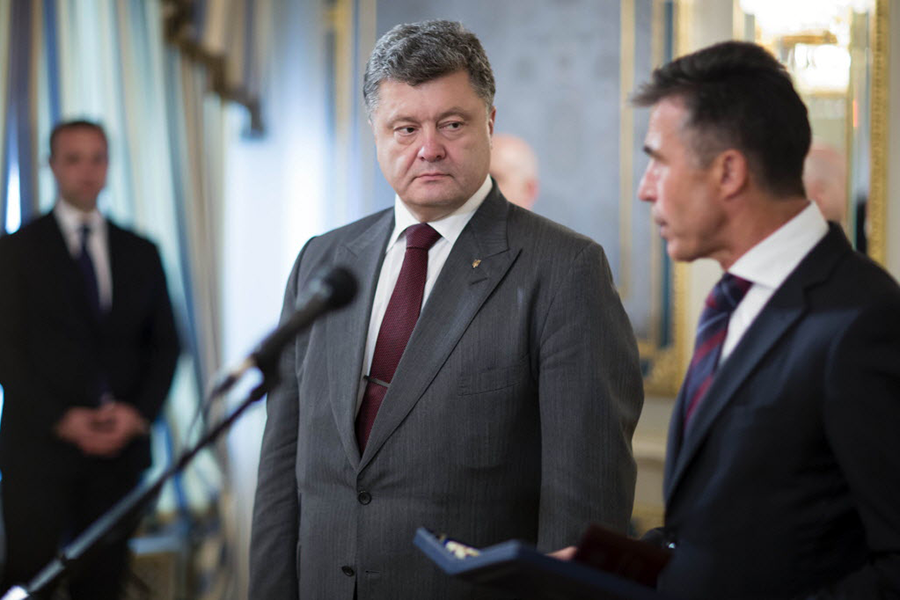Ukraine claims Russian column destroyed, Russia denies reports
Loading...
| KAMENSK-SHAKHTINSKY, Russia
NATO on Friday said a Russian military column ventured overnight into Ukraine, and the Ukrainian president said his forces destroyed most of it. Russia denied all of this, but the reports spooked global markets and overshadowed optimism driven by agreement over a Russian aid convoy bound for eastern Ukraine.
The Russian aid convoy of more than 250 trucks has been a source of tensions since it set off from Moscow on Tuesday. Kiev and the West were suspicious that the mission could be a pretext for a Russian military incursion into eastern Ukraine, where government forces are waging intensifying battles with pro-Russia separatists and clawing back rebel-held territory.
Throughout the eastern crisis that erupted in April, there have been consistent allegations that Russia is fomenting or directing the rebellion. Moscow rejects the allegations and the high-profile aid convoy could be aimed, in part, at portraying Russia as interested in cooling the conflict. Russian President Vladimir Putin appeared to cultivate that perception in a Thursday speech in which he said Russia hopes for peace inUkraine.
It was not clear what Russia could hope to gain by sending in a military column while world attention was trained on its efforts to get the aid convoy into eastern Ukraine.
But some foreign journalists reported that Russian armored personnel carriers were seen crossing intoUkraine on Thursday night. On Friday, a statement on Ukrainian President Petro Poroshenko's website said "the given information was trustworthy and confirmed because the majority of the vehicles were destroyed by Ukrainian artillery at night."
NATO secretary-general Anders Fogh Rasmussen also said Russian military vehicles had entered Ukraine, but he gave no specifics.
In Moscow, a spokesman for the Russian Defense Ministry insisted that no Russian military vehicles were destroyed because none had crossed into Ukraine. Yet Britain said it summoned Russian Ambassador Alexander Yakovenko in to clarify reports of the Russian incursion.
Markets sold off heavily Friday, spooked by thought of Ukrainian troops engaging with Russia forces insideUkraine. Germany's DAX, which had been trading over 1 percent higher, ended the day 1.4 percent lower.
The crossing reportedly took place near the southern Russian town where the aid trucks have been parked, awaiting permission to go into Ukraine.
After days of controversy, Russia nominally consented to let Ukrainian officials inspect the convoy while it was still on Russian soil and agreed that the Red Cross would distribute the goods in Ukraine's region of Luhansk.
Laurent Corbaz, the International Committee of the Red Cross' director of operations in Europe, described a tentative plan in which the trucks would enter Ukraine with a single Russian driver each — as opposed to the current crew of several people in each truck — accompanied by a Red Cross worker. In line with Red Cross policy, there would be no military escort, he said.
However, some Russian military vehicles near the aid convoy were seen Friday carrying a Russian acronym standing for "peacekeeping forces" — a signal that Moscow was considering a possible military escort.
The fighting in eastern Ukraine has claimed nearly 2,100 lives, half of those in the last few weeks as the Ukrainian troops regained more and more rebel-held territory. It began in April, a month after Russia annexedUkraine's Black Sea peninsula of Crimea.
The eastern Ukrainian city of Luhansk has suffered extensively from an intense military barrage over the last few weeks. The city remains cut off from power and water supplies, and its mobile and landline telephone systems barely function, local authorities said Friday. Little food is available but bread is still being made using portable generators.
Ukraine, meanwhile, proceeded with its own aid mission to the Luhansk area. Trucks sent from the eastern city of Kharkiv were unloaded Friday at warehouses in the town of Starobilsk, where the goods were to be sorted and transported further by the Red Cross. Starobilsk is 100 kilometers (60 miles) north of Luhansk.
Other Ukrainian aid was taken to the town of Lysychansk, which retaken by Ukrainian forces late last month but has seen sporadic clashes until earlier this week.
Dozens of houses showed signs of damage Friday in Lysychansk — some had windows blown out, while others had been blasted or burned to the ground. An Associated Press reporter saw small children playing in the rubble of one destroyed house.
As Ukrainian emergency workers discussed how to distribute the aid, clusters of older women and small children began appearing on the town's streets. Residents said the aid was the first they had seen since fighting had ended.
The Russian and Ukrainian presidential chiefs of staff said there would be a meeting Sunday in Berlin between their countries, France and Germany — but that was not confirmed yet by France or Germany.







